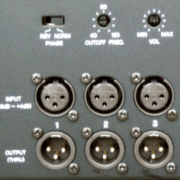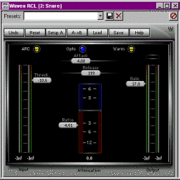PLEASE NOTE: This article has been archived. It first appeared on ProRec.com in January 2000, contributed by then Editor-in-Chief Rip Rowan. We will not be making any updates to the article. Please visit the home page for our latest content. Thank you!
The Bellari RP533 is a tube-based mic preamp featuring compression and exciter circuits.
Like other units in Bellari’s line of tube products, the RP533 is built into a two rack space enclosure with an “antiqued” gold front panel, utilitarian black knobs, and lighted analog meter. The unit has a very utilitarian vintage look – appealing if you like the look, which I do.
Features
The preamp is controlled with a simple gain knob that offers about 30 dB of gain. A phantom power switch is provided on the front panel. Inconveniently, the preamp’s 30 dB pad and phase reverse switches are located on the back of the unit. The location of these switches left me scratching my head, wondering, “what were they thinking?” The RP533 does not offer a low-cut switch.
The preamp feeds an optocompressor with variable threshold, attack, release, ratio, and makeup gain. The front panel meter can be switched to show either the unit’ output or the gain reduction applied by the compressor.
The compressor feeds a phase-modulating exciter circuit that allows the user to add low or high frequency harmonic content to the signal. The exciter is controlled by knobs labeled “bottom” and “definition.” Both the compressor and exciter may be switched out of the circuit.
Inputs and outputs are appropriate to the unit. Balanced XLR and unbalanced ¼” connectors are provided for both the inputs and outputs. The unit features a compressor sidechain circuit, useful if you want to use the compressor for applications like de-essing or ducking.
Operation is simple and straightforward. Hook up your gozintas and cumzoutas and fire the unit up. For our tests, I used the RP533 with microphones including the Neumann U87, Crown CM700, Shure KSM32, Audio-Technica 4050, and Shure SM57; as well as bass guitar.
Performance
The RP533 is designed first and foremost to be a colorful unit. The company makes it quite clear from their promotion and marketing literature that their designs are intended to add color and character to the sound and not to offer pristine straight-line-with-gain sound.
Bellari definitely achieved their goal with the RP533. From the moment I fired up the RP533 I realized that this unit simply didn’t get very clean. The preamp’s output was warm, limited-sounding, and a little boxy. We’re talking about serious color here. The sound immediately made me think “tubes” – it’s the sound of slightly mis-biased tubes that are running just a little too hot. It’s a smoky, bluesy sound that really sounds effected.
One fact I had to take into account was the long warmup time for this unit. All tube gear has to warm up, but I discovered that the RP533 continues to change in tone and gain over a period of 15 to 20 minutes after warm-up. For the review I allowed the RP533 a full one-hour warmup to ensure predictable, consistent operation.
I disliked the unit’s gain knobs. The preamp’s main gain knob provides most of its gain in the first ¼ revolution. Making small adjustments in gain in this sensitive area is difficult. Worse, the unit’s output gain knob is quite quirky. There was a serious boost in gain when moving through the first and last 1/10th revolution of the knob. The middle ¾ of the knob’s range produced no real change in gain. Strange, and irritating.
My first application of the RP533 was on bass guitar. While in general I liked the sound of the RP533 on bass, I felt that it could use a little more gain. Although the sound was clearly colored, there was no setting on the unit that produced much distortion. Hey, if I’m using this unit, it’s because of the tubes and coloration. I feel that I’m deserving of all the distortion I can stand.
I liked the unit’s compressor section for the bass guitar. The compressor added a little pop and sustain to the guitar, and the tube gain stages thickened up the sound and slightly limited the transients, adding meat and hair to the sound.
I tried out the exciter section and found that I did not care for it. The bass enhancement was middy and ill-defined, and the treble enhancement was a touch on the gritty side. I’ll point out that I’m no big fan of similar processes available on other units, so I’m not surprised that I didn’t like the RP533’s exciter. If sonic exciters are part and parcel of your sonic mojo, you might really like the RP533’s exciter.
I used the RP533 on a variety of vocals, including three male and one female vocalist. I felt the RP533 had the most to offer when used with neutral-sounding mics like the AT4050 and the KSM32. You definitely get the idea that some kind of tube gear is in the signal path. The sound is pumped-up, browned-up, and just a little covered-up.
It’s not a sound that works on everything. When it doesn’t work, it sounds a little dull and brown, and slightly lacking in depth. There were several applications of this preamp that simply didn’t work. The unit can be a little harsh and sibilant, edgy, and “covered up”. In particular, delicate sources like the female singer I was recording did not translate well with the RP533 (though I might have liked the RP533 on a loud, bluesy female single).
But when the sound works, it’s great. We recorded some vocals for a song where we were really going for an antiqued sound, kind of faded and brown. The RP533 was just the ticket. It added plenty of warmth, and really thickened up the sound.
I also liked the RP533 on snare drum. The heavily limited sound of the preamp added weight and meat to the snare drum, and I could effectively use the tube stages to limit the attack of the snare. The slight distortion produced by driving the preamp hard was the perfect color. Interestingly, I used the exciter circuit on the snare to add treble and liked it – it added a crisp, tough slap that wasn’t as “pretty” as EQ.
I also liked the RP533 on electric guitar. In particular I liked running the preamp hot, with a good dose of heavy, fast compression and a lot of gain in the make-up stage. The RP533 definitely added size and energy to the guitar track. I also used the RP533 to “brown-up” some electronic drum loops. Between the unit’s compressor and the overall limited sound of the preamp, the RP533 made these sterile loops more flavorful and organic.
Conclusion
It may come across as a slap in the face to call the RP533 a “rack-mountable stompbox” but I’ll do it anyway. If you use words like “airy”, “transparent” and “open” to describe the sounds you like, you probably want to look elsewhere. The RP533 is not your preamp. There is no sound that comes out of this preamp uncolored. I wouldn’t recommend the RP533 for your “gold channel”.
But if you’re looking for something to add character to your tracks, the RP533 may be your ticket. Unless you’re another one of those audiophile engineers that thinks that the secret to great recording is to completely and accurately capture all sounds as distortion-free as possible, you will probably find some good uses for the Bellari RP533. The RP533 is a great addition to an established rig to add color and flavor to your tracks.


